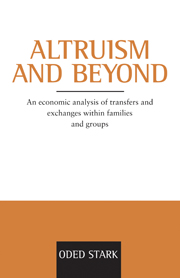Book contents
- Frontmatter
- Contents
- Preface
- Introduction
- 1 Altruism, transfers, and wellbeing
- 2 The timing of intergenerational transfers: an implication
- 3 An exchange implication of transfers: the demonstration effect
- 4 Transfers by migrants: a strategic motive for remittances
- 5 Exchange with recognition costs: an explanation of migrants' performance
- 6 Intrafamilial transfers and exchanges: forming and sustaining altruism
- Index
2 - The timing of intergenerational transfers: an implication
Published online by Cambridge University Press: 23 September 2009
- Frontmatter
- Contents
- Preface
- Introduction
- 1 Altruism, transfers, and wellbeing
- 2 The timing of intergenerational transfers: an implication
- 3 An exchange implication of transfers: the demonstration effect
- 4 Transfers by migrants: a strategic motive for remittances
- 5 Exchange with recognition costs: an explanation of migrants' performance
- 6 Intrafamilial transfers and exchanges: forming and sustaining altruism
- Index
Summary
Introduction
A fairly strong positive association exists between per capita income and life expectancy across developing countries. Even though associations do not reveal causality, in this case one explanation of the association is as transparent as the association itself: countries that master means and resources to provide more and higher-quality health and health related services end up having longer-lived residents. The possibility that causality runs in exactly the opposite direction, that is, that longer life expectancy translates into higher per capita income, is less well recognized. This possibility is taken up in the current chapter. Specifically we study the chain that longer life expectancy encourages larger investments in human capital which in turn facilitates the attainment of higher per capita income. Although in itself this chain is not novel, the proposed microeconomic rationale which underlies the observed macroeconomic relationship is.
When education and skills are more abundant, countries produce more. Although the close link between investment in human capital, per capita income, and growth is well documented (e.g., Lucas [1988], Romer [1990], Azariadis and Drazen [1990], Ehrlich and Lui [1991], Mankiw, Romer and Weil [1992], Galor and Zeira [1993]) the underlying mechanism is not yet fully understood. Becker, Murphy and Tamura (1990) have suggested an explanation that draws on the role of fertility behavior: higher fertility is assumed to raise the rate of discount in the intertemporal utility function, thereby discouraging investment in human capital.
- Type
- Chapter
- Information
- Altruism and BeyondAn Economic Analysis of Transfers and Exchanges within Families and Groups, pp. 31 - 48Publisher: Cambridge University PressPrint publication year: 1995

